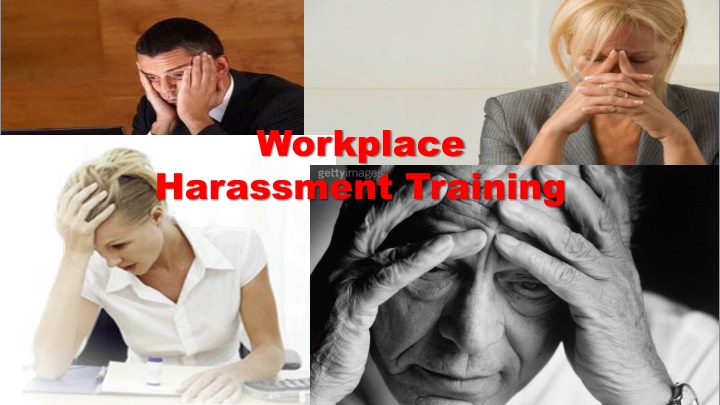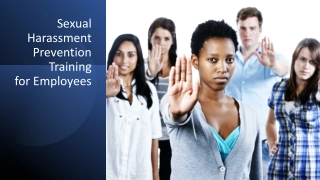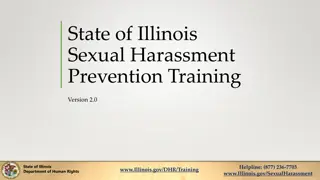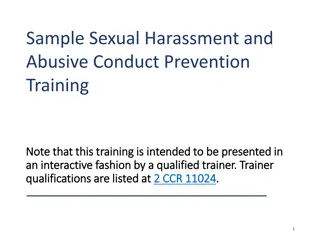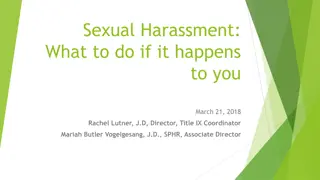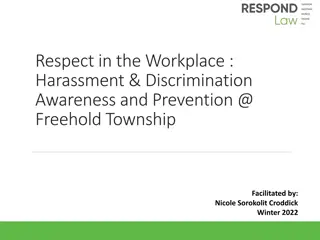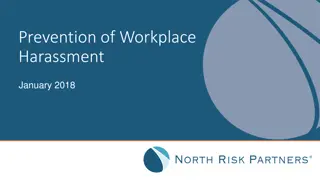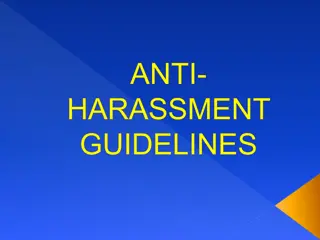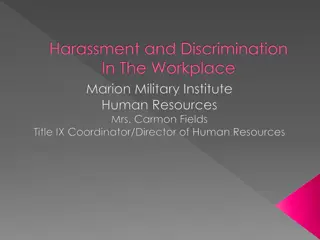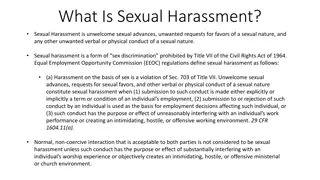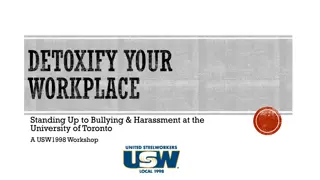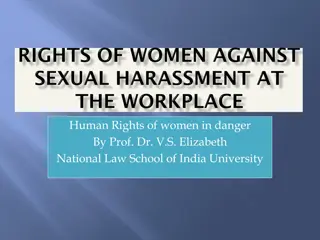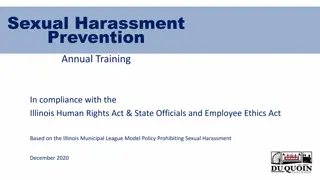Workplace Harassment Training
Harassment training raises awareness about unacceptable behaviors, defines harassment, lists forms of harassment, emphasizes zero tolerance policies, and addresses sexual harassment in the workplace. It outlines consequences, identifies perpetrators and targets, and stresses the importance of maintaining a safe and inclusive work environment.
Download Presentation

Please find below an Image/Link to download the presentation.
The content on the website is provided AS IS for your information and personal use only. It may not be sold, licensed, or shared on other websites without obtaining consent from the author.If you encounter any issues during the download, it is possible that the publisher has removed the file from their server.
You are allowed to download the files provided on this website for personal or commercial use, subject to the condition that they are used lawfully. All files are the property of their respective owners.
The content on the website is provided AS IS for your information and personal use only. It may not be sold, licensed, or shared on other websites without obtaining consent from the author.
E N D
Presentation Transcript
Workplace Harassment Training
Workplace Harassment Training and its Purpose To Bring awareness about the serious and unacceptable nature of Harassment actions and the sever consequences that could follow. Federal law defines harassment as unwelcome verbal or physical conduct or actions, based on race, religion, sex, national origin, age, disability, genetic information, military membership or veteran status, severe or pervasive enough to create a hostile, abusive or intimidating work environment for a reasonable person.
What is Harassment? Harassment is any form of discrimination that consist of words, signs jokes, pranks, intimidation, physical actions or violence that is directed at an employee due to any protected characteristics. These include age, race, religion, color, national origin, sexual orientation, military statues, sex, disability, marital status, domestic violence victim status, gender identity and criminal history. Harassment includes: offensive behavior based on stereotypes about a protected class and behavior that is intended to cause discomfort or humiliation because of a protected characteristic. It also includes any expression of contempt or hatred for that group to which the victim belongs base on a protected characteristic.
ZERO TOLERANCE! Cameron County has a zero tolerance policy toward harassment. Any harassing behavior will be investigated and the perpetrator (s) will be told to stop. Disciplinary action will be taken, if necessary, up to and including termination from employment if necessary.
What could be considered What could be considered harassment? harassment? Offensive jokes, suggestive or degrading comments. Unwanted advances or continual invitations for dates. Offensive physical contact. Offensive pictures, posters or written material. Threatening, abusive or offensive calls, letters, emails or SMS messages.
Sexual Harassment in the Work Place Cameron County is committed to ensuring that all individuals have an equal opportunity to enjoy a fair, safe and productive work environment. Preventing sexual harassment is critical to our continued success. Sexual harassment will not be tolerated. Rest assured that any report of sexual harassment will be taken seriously and promptly investigated with effective remedial action taken where appropriate.
Who are Who are Perpetrators Perpetrators? ? Anyone in the workplace a coworker, supervisor, manager, vendor, client, subcontractor or visitor. Who are Targets Who are Targets? ? Targets can be males, females, transgender or persons of the same sex. The law protects employees and non- employees who work in the workplace, including independent contractors and those employed by companies contracting to provide services in the workplace.
Two Main Types of Sexual Harassment Hostile Environment Hostile Environment Exists when one's behavior within a workplace creates an environment that is difficult or uncomfortable for another person to work in, due to discrimination. Quid Quid Pro Quo Pro Quo An exchange of goods or services, in which one transfer is contingent upon the other; "a favor for a favor".
Hostile Environment Hostile environment harassment includes: Sexual or discriminatory displays or publications anywhere in the workplace, such as displaying pictures, posters, calendars, graffiti, objects, promotional material, reading materials or other materials that are sexually demeaning or pornographic. This includes such sexual displays on workplace computers or cell phones, and sharing such displays while in the workplace. Hostile actions taken against an individual because of that individual s sex , such as: Interfering with, destroying or damaging a person s workstation, tools or equipment or otherwise interfering with the individual s ability to perform the job; Sabotaging an individual s work; Bullying, yelling, name calling.
Hostile Environment Cont. This type of harassment occurs between an employee and someone with authority, like supervisor, who has the ability to grant or withhold job benefits. Quid pro quo sexual harassment includes: Offering or granting better working conditions or opportunities in exchange for a sexual relationship Threatening adverse working conditions (like demotions, shift alterations or work location changes) or denial of opportunities if a sexual relationship is refused. Using pressure, threats or physical acts to force a sexual relationship Retaliating for refusing to engage in a sexual relationship.
Where can Sexual Harassment Where can Sexual Harassment Occur Occur? ? Harassment can occur whenever and wherever employees are fulfilling their work responsibilities, including in the field, at any employer-sponsored event, training, conferences open to the public and office parties. Employee interactions during off hours, such as a hotel while traveling or at events after work can have an impact in the workplace. Locations off site and off-hour activities can be considered extensions of the work environment. Harassing behavior that in any way affects the work environment is rightly the concern of management.
Other Types Harassment Sex Stereotype: Sex stereotyping occurs when conduct or personality traits are considered inappropriate simply because they may not conform to other people s ideas or perceptions about how individuals of either sex should act or look. Harassing a person because that person does not conform to gender stereotypes as to appropriate looks, speech, personality or lifestyle is sexual harassment Harassment because someone is performing a job that is usually performed or was performed in the past, mostly by person of the opposite sex, is sex discrimination.
Other Types Harassment Cont. Religion: Harassment based on religion occurs when an employee is antagonized or ridiculed because of his/her religious beliefs. Another type of religious harassment occurs when a co-worker or supervisor preaches or attempts to convert an employee and the employee perceives that behavior to be unwanted and offensive, amounting to a hostile work environment. ***To avoid claims of religious harassment, employer must reasonably accommodate an employee s sincerely held religious practice unless doing so would impose an undue hardship on the business.
Workplace Workplace Bullying Bullying Workplace bullying is repeated mistreatment of one or more employees using humiliation, intimidation and denigration of performance. Bullying behavior can exist at any level of an organization. Bullies can be superiors, subordinates, co-workers and colleagues. EXAMPLES of Workplace Bullying Verbal abuse and profanity Humiliation Constant criticism or teasing Gossip Stealing the credit for work performed by the victim Personal and professional denigration. Overt threats Assignment of unrealistic workloads Aggressive emails or notes Profession exclusion or isolation Sabotage of career and financial statues
Other Types Harassment Cont. Race/Color: Ethnic slurs or jokes, offensive or derogatory comments, or other verbal or physical conduct based on an employee s race/color constitutes harassment if that conduct creates an intimidating, hostile or offensive work environment and prohibits an employee from performing his/her job.
Illegal Harassment vs Inappropriate Conduct Illegal Harassment vs Inappropriate Conduct or or Behavior Behavior For purposes of this training harassment refers to the illegal form of discrimination. Employees may think they are being harassed, when they are subject to inappropriate conduct or behavior that is not illegal but that is unacceptable in the workplace. This could be described as workplace bullying although bullying techniques can also be used again employees based on their legally protected status. While all harassment is not illegal, no form of harassment should be tolerated in the workplace.
Supervisor Supervisor Responsibility Responsibility Supervisors must report any must report any harassment that they observe or know of; even if no one is objecting to the harassment. Supervisors must promptly report any incident without exception Even if they think the conduct is trivial Even if the harassed individual asks that it not be reported Supervisors will be subject to discipline for failing to report complaints or for engaging in any types of retaliation.
What to Do If You Feel Youre What to Do If You Feel You re Being Being Harassed Harassed If you feel comfortable doing so, tell the person who is harassing to stop! If you do not feel comfortable confronting the harasser directly, or if the behavior does not stop, follow the steps below: Immediately tell our Supervisor. You can talk with your own Supervisor, the Supervisor of the person who is harassing you, or any Supervisor in the organization. Explain what has happened and ask for that persons / help in getting the behavior to stop. If you do not feel comfortable telling a Supervisor then contact the Human Resources Dept. Remember; the law protects you from retaliation (punishment) for complaining about harassment. You have a right to report harassment
